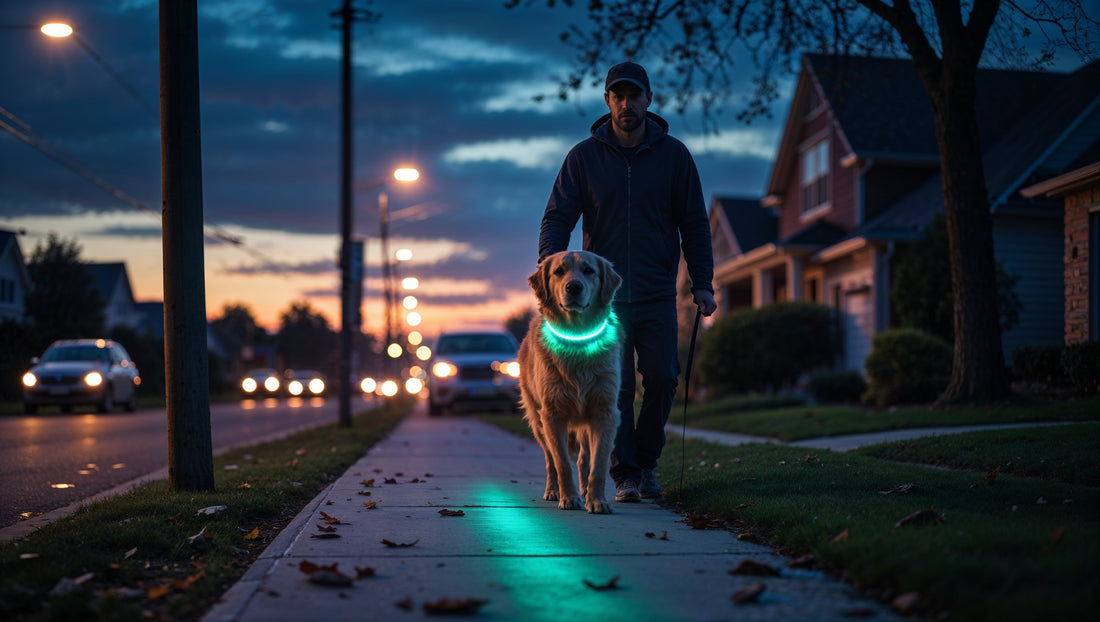As daylight hours shorten and busy schedules push dog walks into early morning darkness or evening twilight, pet owners face increasing safety challenges. Walking dogs in low-light conditions presents risks that many owners don't fully consider until they find themselves in a dangerous situation. From cars that can't see approaching pedestrians to other dogs whose behavior is harder to read in darkness, evening and early morning walks require special preparation and equipment to keep both you and your furry companion safe.
The statistics surrounding pedestrian and pet safety during dark hours are sobering. According to traffic safety data, pedestrian fatalities are nearly three times more likely to occur in darkness than during daylight hours. While specific data for dog walking incidents is limited, emergency veterinary clinics report increased admissions for trauma-related injuries during evening hours, suggesting that darkness significantly increases accident risks for pets as well.
However, avoiding nighttime walks entirely isn't realistic for most pet owners. Work schedules, seasonal daylight changes, and dogs' exercise needs often make evening or early morning walks necessary. The solution isn't to eliminate these walks but to approach them with proper preparation, appropriate safety equipment, and heightened awareness of potential hazards.
Understanding the Unique Risks of Dark-Hour Dog Walking
Darkness fundamentally changes the dynamics of dog walking in ways that extend far beyond simple visibility issues. While the obvious concern is being seen by vehicles, the risks encompass a much broader range of safety considerations that responsible pet owners must address.
Vehicle-related dangers top the list of nighttime walking concerns. Drivers have significantly reduced reaction time in low-light conditions, and many fail to anticipate pedestrians with dogs during typical commuting hours. Even reflective clothing on humans may not be sufficient if the dog remains invisible until the last moment. The unpredictable movements of dogs—sudden direction changes, stopping to investigate scents, or pulling toward interesting stimuli—create additional challenges for drivers trying to navigate safely around pedestrians.
Environmental hazards become more difficult to spot in darkness. Broken glass, holes in walking paths, ice patches during winter months, and other obstacles that would be easily avoided during daylight can cause injuries to both dogs and their owners. Dogs rely heavily on scent rather than sight, which means they may not notice visual hazards that could injure their paws or legs.
Wildlife encounters increase during dawn and dusk hours when many animals are most active. Depending on your geographic location, this could mean anything from aggressive raccoons or skunks to more dangerous predators. Dogs' natural curiosity and hunting instincts may lead them toward these encounters, putting both pet and owner at risk.
Other dogs and their owners present unique challenges during dark walks. Aggressive or poorly socialized dogs may behave more unpredictably in low-light conditions, while responsible owners may have difficulty reading body language and preventing conflicts before they escalate. The reduced visibility makes it harder to identify approaching dogs' breeds, sizes, and temperaments, limiting your ability to make informed decisions about interactions.
Criminal activity, while not common, does increase during dark hours in many areas. Dog walkers can become targets for theft, particularly if they appear distracted or vulnerable. Additionally, dogs provide a false sense of security that may lead owners to venture into areas or situations they would avoid when alone.
Essential Safety Equipment for Night Walking
Proper equipment forms the foundation of safe nighttime dog walking. While basic reflective gear represents a good starting point, comprehensive safety requires multiple layers of visibility enhancement and protective measures.
LED collars and leashes have revolutionized nighttime pet safety by providing active illumination rather than passive reflection. Unlike reflective materials that only work when light hits them at the correct angle, LED safety equipment creates its own light source, making dogs visible from all directions and much greater distances. Modern LED collars offer multiple flash patterns, solid illumination options, and impressive battery life that can last for weeks of regular use.
The advantages of LED safety equipment extend beyond simple visibility. The bright, colorful lights help identify your dog's location even when they're moving through tall grass, behind obstacles, or at the maximum extent of their leash. This continuous visual connection provides peace of mind and allows for quicker response if your dog encounters problems or potential dangers.
High-quality LED collars feature weather-resistant construction, comfortable fit systems, and easy-to-use controls that work even with gloved hands during cold weather. Many offer multiple color options, allowing owners to choose colors that provide maximum visibility in their specific walking environments or to coordinate with other safety equipment.
Reflective gear for humans remains important even when dogs wear LED equipment. Reflective vests, arm bands, and shoe attachments help drivers and other pedestrians identify the human component of the walking team. This dual approach—active illumination for dogs and passive reflection for humans—provides comprehensive visibility that addresses the unique movement patterns and positions of both species during walks.
Flashlights and headlamps serve multiple safety functions beyond simple path illumination. They help identify potential hazards on walking surfaces, allow owners to monitor their dogs' behavior and bathroom needs, and can be used to signal approaching vehicles if necessary. Modern LED flashlights provide powerful, long-lasting illumination while remaining lightweight and comfortable for extended use.
Personal safety devices, including whistles, personal alarms, and pepper spray (where legal), provide options for handling emergency situations. While most nighttime walks proceed without incident, having tools available for unusual circumstances provides confidence and practical protection for both routine and emergency situations.
Planning Safe Routes and Timing
Strategic route planning becomes crucial for nighttime dog walking safety. The familiar neighborhood paths that work perfectly during daylight hours may present unacceptable risks after dark, requiring careful evaluation and often complete route redesign.
Well-lit areas should form the backbone of any nighttime walking route. Streets with consistent streetlight coverage, parking lots with security lighting, and paths through well-maintained parks with adequate illumination provide safer alternatives to dark residential streets or unlit trails. However, lighting quality matters as much as quantity—harsh, glaring lights that create deep shadows can be nearly as dangerous as complete darkness.
Traffic patterns change significantly during typical dog walking hours. Morning walks may coincide with rush hour traffic, while evening walks often occur during another peak traffic period. Understanding these patterns and choosing routes that minimize exposure to high-traffic areas or provide safe alternatives like sidewalks and crosswalks can dramatically reduce accident risks.
Familiar routes offer advantages during dark walks because both owner and dog know the terrain, potential hazards, and typical activity patterns. However, familiarity can also breed complacency, leading to reduced attention to changing conditions or new hazards. The ideal approach combines familiar routes with heightened awareness and regular reassessment of safety conditions.
Weather conditions dramatically affect nighttime walking safety. Rain, snow, ice, and fog all reduce visibility further while creating additional hazards like slippery surfaces and unpredictable vehicle behavior. Having alternative indoor exercise options or postponing walks during severe weather conditions prioritizes safety over exercise schedules.
Timing considerations extend beyond simple darkness factors. Very early morning walks may encounter different hazards than evening walks, including increased wildlife activity, different traffic patterns, and varying numbers of other pedestrians. Understanding these patterns helps in choosing optimal times and preparing for specific risks associated with different periods.
Behavioral Considerations for Dogs in Low-Light Conditions
Dogs experience and react to darkness differently than humans, and understanding these differences is crucial for maintaining safety during nighttime walks. While dogs generally have better night vision than humans, their behavior can change significantly in low-light conditions, requiring adjusted handling and management techniques.
Many dogs become more alert and sometimes anxious during dark walks. Sounds seem louder and more threatening, scents are more concentrated and noticeable, and the inability to clearly see their surroundings can create stress. This heightened alertness can be beneficial for detecting potential problems but may also lead to overreaction to normal nighttime sounds and activities.
Some dogs exhibit increased territorial behavior during evening hours, possibly due to evolutionary patterns that associate darkness with potential threats. This may manifest as more barking at other dogs, increased marking behavior, or resistance to moving through areas they navigate easily during daylight. Understanding and managing these behaviors prevents conflicts and keeps walks moving smoothly.
The reduced ability to read environmental cues in darkness can make some dogs more dependent on their owners for guidance and reassurance. This presents opportunities for strengthening the human-dog bond through clear leadership and consistent direction, but also requires owners to be more attentive to their dogs' stress signals and comfort levels.
Younger dogs and seniors may need special consideration during dark walks. Puppies may be more fearful of unfamiliar nighttime sounds and sights, while older dogs with declining vision may have difficulty navigating familiar routes in darkness. Adjusting expectations, providing additional patience, and ensuring these dogs have proper visibility equipment becomes even more important.
Training and Preparation Strategies
Successful nighttime walking requires specific training and preparation that goes beyond basic leash manners and obedience skills. Dogs and owners both need to develop skills and habits specifically designed for low-light conditions.
Gradual introduction to darkness helps dogs adjust to nighttime walks without developing fear or anxiety. Start with walks during twilight hours and gradually extend into full darkness as your dog becomes comfortable. This process allows dogs to adjust naturally while building positive associations with evening exercise routines.
Enhanced recall training becomes crucial when visibility is limited. Dogs must respond immediately to commands when owners spot potential hazards or need to redirect attention. Practice recall commands in various lighting conditions and with different distractions to ensure reliability when it matters most.
Leash management skills require refinement for nighttime conditions. Owners need to maintain closer control while still allowing dogs freedom to exercise and explore safely. This often means shorter leash lengths, more consistent tension, and greater awareness of the dog's position relative to the owner and potential hazards.
Emergency procedure practice helps both dogs and owners respond appropriately to unexpected situations. This includes training dogs to come immediately when called, teaching emergency stops and direction changes, and practicing human responses to various scenarios like aggressive animals, vehicle encounters, or injury situations.
Technology and Innovation in Pet Safety
The pet safety industry continues to develop innovative solutions for nighttime walking challenges. GPS tracking collars allow owners to monitor dogs' locations even when visibility is limited, while smartphone apps can track walking routes, log exercise data, and even provide emergency contact features.
Smart LED collars now offer features like smartphone connectivity, GPS integration, and programmable light patterns. Some models can be controlled remotely, allowing owners to change light settings or activate emergency signals without physically reaching the collar.
Reflective and LED leashes complement collar safety equipment by providing additional visibility along the entire length of the connection between dog and owner. Some advanced models include built-in flashlights, emergency whistles, or even smartphone charging capabilities for extended walks.
Wearable technology for humans continues expanding with devices designed specifically for dog walkers. GPS watches can track routes and provide emergency communication, while specialized apps can send automatic location updates to family members during walks.
Community and Environmental Considerations
Nighttime dog walking operates within broader community contexts that responsible pet owners must consider. Noise levels, light pollution, and interactions with neighbors all require thoughtful management during evening and early morning exercise routines.
Bark management becomes more important during quiet nighttime hours when sounds carry farther and neighbors are more likely to be disturbed. Training dogs to remain calm and quiet during encounters with other animals or people helps maintain positive community relationships while ensuring continued access to walking areas.
Light pollution from safety equipment should be considered in relation to neighbors and local wildlife. While visibility is crucial for safety, choosing appropriate brightness levels and light patterns can minimize disruption to sleeping neighbors or sensitive wildlife areas.
Community resources like well-lit walking trails, dog parks with extended hours, and neighborhood watch programs can provide additional safety support for nighttime dog walkers. Engaging with these resources and contributing to community safety efforts benefits all pet owners while building relationships that enhance overall neighborhood security.
Health Benefits vs. Safety Risks
While safety concerns are paramount, the health benefits of regular exercise for both dogs and humans remain important considerations. Dogs require consistent exercise regardless of daylight availability, and many owners find that evening walks provide valuable stress relief and exercise opportunities after long work days.
The key lies in risk management rather than risk elimination. By using appropriate safety equipment, planning safe routes, and maintaining awareness of potential hazards, the benefits of regular exercise can be preserved while minimizing safety risks to acceptable levels.
Seasonal adjustments help maintain exercise routines while adapting to changing daylight patterns and weather conditions. Winter months require different safety considerations than summer evenings, and successful nighttime walking programs must adapt to these variations while maintaining consistency in exercise schedules.
Conclusion: Making Night Walks Safe and Enjoyable
Nighttime dog walking doesn't have to be dangerous or stressful. With proper preparation, appropriate safety equipment, and awareness of potential risks, these walks can become enjoyable bonding experiences that provide necessary exercise while building stronger relationships between dogs and their owners.
The investment in quality safety equipment pays dividends in peace of mind and actual protection. LED collars, reflective gear, and proper lighting transform potentially dangerous situations into manageable challenges while ensuring that dogs remain visible and safe throughout their evening adventures.
Remember that safety equipment is only as effective as the preparation and awareness that accompanies it. Combining high-quality visibility gear with route planning, training, and environmental awareness creates comprehensive protection that allows both dogs and owners to enjoy the unique pleasures of nighttime exploration while minimizing risks and maximizing safety for all involved.


